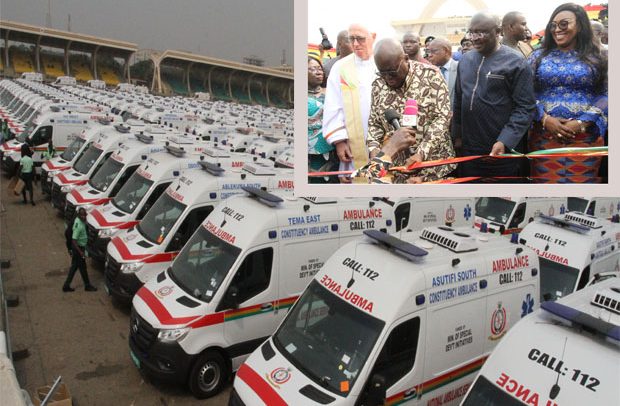An aerial view of some of the 307 bambulances at the Independence Square, Accra. Inset: President Akufo-Addo being supported by Vice-President Dr. Bawumia to inaugurate the ambulances. With them is Hawa Koomson. Picture by Gifty Ama Lawson.
President Nana Addo Dankwa Akufo-Addo yesterday commissioned 307 ambulances for distribution across the country, a major boost to emergency medical delivery system.
Each of the 275 constituencies has been given an ambulance while the rest are to be distributed to emergency areas, hospitals and probably the National Disaster Management Organisation (NADMO).
Symbolic Commissioning
The ambulance for Ho West was used by the President for the symbolic commissioning exercise, with Father Andrew Campbell offering a prayer.
While commissioning the ambulances at the Black Star Square in Accra, the President observed that the 2016 manifesto of the NPP made a firm promise to improve the fortunes of Ghana’s National Ambulance Service (NAS).
He noted that he took over the affairs of the country with an ambulance service which was in a very poor state.
Emergency Numbers
He, however, had cause to caution Ghanaians not to abuse the emergency contact number, 112, which was supposed to give a great boost in the healthcare system. This, he said, was because some people had been misusing the emergency service numbers, a development he said could in itself put human lives at risk.
“I will appeal that this improvement in the provision of emergency services be not abused. We are told that 90% of calls made to the providers of emergency services are usually prank calls. This is not right as it only endangers the life of Ghanaians in need,” he said.
President Akufo-Addo also took the opportunity to ask all 16 regional ministers in the country as well as metropolitan and municipal chief executives and all health officials to provide the needed cooperation and support to make the operationalisation of the 307 ambulances a success.
He also urged the NAS to ensure satisfactory maintenance of the ambulances, indicating that “the goal of this government is to establish in our country, a strong and accessible healthcare system of world class quality which will ensure the health and well-being of our people and I entreat all of you to be an integral part of this visions.”
Health Minister
Health Minister Kwaku Agyemang-Manu said accessibility to healthcare would improve significantly with the deployment of the ambulances.
He urged his colleague Members of Parliament (MPs) to assist the NAS to serve their respective constituents.
“I will like to call on the Director-General of the Ghana Health Service, the CEOs of the teaching hospitals, the regional directors of health services as well as heads of all ministry of health agencies to cooperate and collaborate with NAS as they carry out their duties in providing pre hospital-care services in the country so that together we can all assist in the building of a comprehensive, effective and efficient emergency response system for our country,” he said.
The various ambulances for the Upper East, North East, Northern, Savannah, Upper West regions were dispatched immediately after the commissioning.
NAS Stations
Per yesterday’s commissioning, a total of 145 new ambulance stations had been added to the NAS stations nationwide.
According to the CEO of NAS, Prof. Ahmed Nuhu Zakariah, the 145 new stations are the highest single addition in the history of ambulance services in Ghana.
He stated that 307 is the highest fleet in the history of the procurement of ambulances for emergency healthcare in Africa.
He said NAS was established in 2004 and started in 2005 with seven stations in three regions, and in 2006, it started full scale operation with additional 12 stations.
Ambulance Procurement
The ambulances were procured under the government’s Infrastructure for Poverty Eradication Programme (IPEP) currently being implemented by the Ministry of Special Development Initiatives, headed by Mavis Hawa Koomson, who doubles as an MP.
Since the establishment of the Ghana Ambulance Service with an initial investment by the Kufuor administration in 2004 with some 10 ambulances and seven stations, emergency healthcare has ground to a halt in recent years, leaving the ambulance service with only some 55 ambulances functioning currently and a handful of emergency medical technicians.
Meanwhile, financial clearance has been given for the recruitment and training of 1, 477 medical technicians.
Out of that figure, 577 people have started receiving training in that respect.
By Charles Takyi-Boadu & Melvin Tarlue


